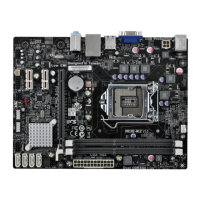
Do you have a question about the ECS H61H2-M12 and is the answer not in the manual?
| Memory channels | Dual-channel |
|---|---|
| Number of memory slots | 2 |
| Supported memory types | DDR3-SDRAM |
| Maximum internal memory | 16 GB |
| Processor socket | LGA 1155 (Socket H2) |
| Processor manufacturer | Intel |
| Compatible processor series | Intel Celeron, Intel Pentium |
| Maximum number of SMP processors | 1 |
| CPU fan connector | Yes |
| Number of SATA II connectors | 4 |
| Number of Parallel ATA connectors | 0 |
| USB 2.0 ports quantity | USB 2.0 ports have a data transmission speed of 480 Mbps, and are backwards compatible with USB 1.1 ports. You can connect all kinds of peripheral devices to them. |
| Component for | PC |
| Power source type | ATX |
| Motherboard chipset | Intel® H61 |
| Audio output channels | 5.1 channels |
| Motherboard form factor | micro ATX |
| Supported storage drive interfaces | SATA II |
| On-board graphics card | - |
| Parallel processing technology support | Not supported |
| Networking features | Fast Ethernet |
| BIOS type | AMI |
| BIOS memory size | 32 Mbit |
| Depth | 170 mm |
|---|---|
| Width | 225 mm |
Covers copyright notice, manufacturer disclaimers, and trademark recognition.
Details compliance with FCC rules for digital devices and interference.
Outlines the manual's chapters and their content.
Introduces the motherboard, socket, chipset, and general features.
Details the processor socket, Intel H61 Chipset, DDR3 memory support, and audio.
Lists expansion slots, SATA connectors, and rear panel I/O ports.
Explains the AMI BIOS features for system configuration and management.
Covers safety precautions, grounding, and choosing a compatible computer case.
Explains how to set jumpers for system configuration and motherboard options.
Guides on installing the CPU, memory modules, and expansion cards.
Details connecting I/O ports, case components, and internal headers like SATA and USB.
Introduces the BIOS Setup Utility, its functions, and navigation methods.
Covers system language, date/time, CPU, SATA, USB, and Super IO configurations.
Details chipset configurations, memory settings, performance tuning, and boot device priorities.
Explains security passwords, exiting setup, and the procedure for updating the BIOS.
Describes the support disc contents and the auto-installation process for drivers and utilities.
Guides on manual driver installation and references available utility software.
Addresses issues like no power, no display, and sudden shutdowns during assembly.
Covers startup problems after extended use and provides PC maintenance tips.
Offers a step-by-step visual guide for diagnosing common PC startup failures.
